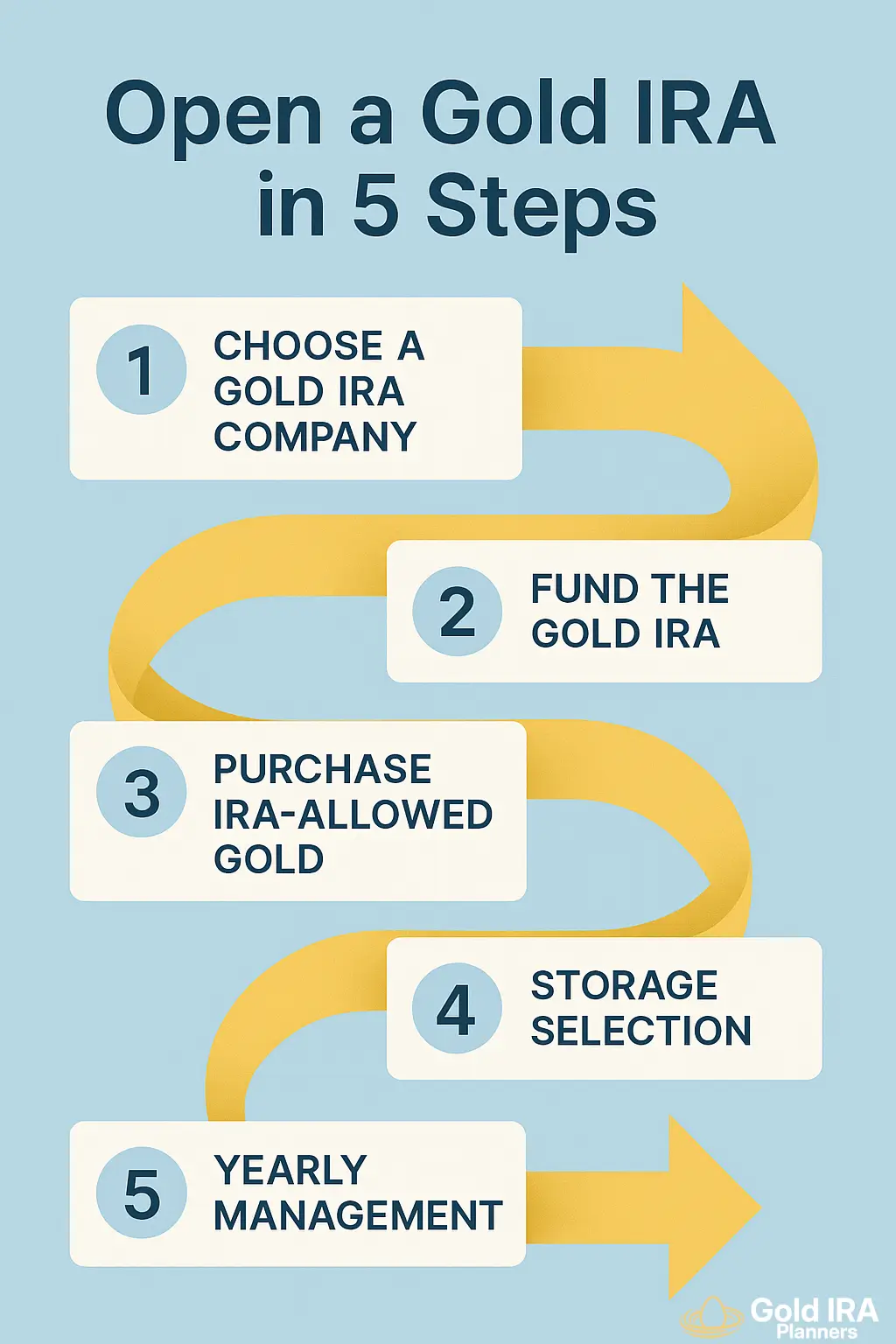Gold IRA: What It Is, How It Works, Pros/Cons
Investing in physical gold for retirement can be done through a self-directed Individual Retirement Account (IRA), allowing you to hold gold directly within your retirement portfolio. Gold IRA Planners details what this type of investment account is, how it works, and why investors are turning to this alternative asset for diversification in our Gold IRA guide.

What is a Gold IRA?
A Gold IRA (Precious Metals IRA) is a self-directed IRA to hold physical gold and other precious metals in a retirement portfolio, while maintaining the tax advantages of a Traditional or Roth IRA. Gold IRAs allow for diversification with tangible assets that can act as a hedge against inflation and economic downturns. Holding gold in an IRA is often seen as a long-term investment strategy in retirement.
Benefits
The benefits of Gold IRAs outline unique reasons to include gold in your retirement, including its potential growth, diversification options, and direct asset control. Below are key benefits to factor in before starting a Gold IRA:
Drawbacks
Gold IRAs also come with potential downsides. These include no income or dividends from the metal itself, higher fees than Traditional IRAs, and strict IRS rules on account setup and withdrawals. Below are the risks of Gold IRAs:

Holding Physical Gold in an IRA
You can hold physical gold in an IRA, but only through a self-directed IRA that allows IRS-approved precious metals. Physical gold in a Gold IRA is held by a custodian in a secure depository. Custodians and depositories are approved by the Internal Revenue Service (IRS), ensuring your investment is protected. On average, the process can take 7 to 14 days to establish a Gold IRA and complete the investment.
You can invest in gold while still maintaining a diversified portfolio in paper assets like stocks and mutual funds. Alternative investments allow for a more robust portfolio with a mix of assets. There's also the option of investing in physical gold outside retirement offering flexibility, but it lacks the tax advantages of a Gold IRA, which is better suited for long-term retirement growth.
How to Open a Gold IRA
Opening a Gold IRA involves 5 key steps. Detailed below are the 5 steps to understand how a Gold IRA works:
1. Choose a Gold IRA Company
Opening a Gold IRA starts with selecting a Gold IRA company who will help you through the process. These companies help you establish a self-directed Gold IRA and partner with IRS-approved custodians and depositories who manage your self-directed Gold IRA. Compare company reviews, reputations, and fee structures to see what's right for your investment. Companies usually provides a free Gold IRA kit you can learn more about their services. (See our company comparison page)
2. Fund the Gold IRA
There are three ways to move funds to a Gold IRA: transfers, rollovers, and contributions. Transfers apply to other IRAs. Rollovers cover employer-sponsored plans like to roll over a 401(k) to gold. Contributions follow standard IRS limits. You must purchase gold directly through the IRA account. Pre-owned gold cannot be added. The funding method you choose depends on where the funds are coming from.
Deciding how much to invest in a Gold IRA comes down to your investment goals, but you'll typically see a 5-20% allocation of a retirement portfolio. Speak with your financial advisor to determine the right amount for you and whether to allocate it all at once or in phases.
3. Purchase IRA-Allowed Gold
With funds now in a self-directed Gold IRA, you'll purchase IRS-approved gold coins or bars. Gold must meet a minimum fineness of .995 or higher with common choices including American Gold Eagles, Canadian Gold Maple Leafs, and reputable gold bars.
The company you open an account with will help you select the metals, purchase them through a trusted dealer, and store them with a custodian. Just like gold, you can also invest an IRA in silver, platinum, and palladium through a self-directed IRA. For example, the IRA rollover process in silver is the same as gold as long as they are IRA-allowed products.
4. Storage Selection
The metals are then stored in an IRS-approved depository, in either segregated or non-segregated storage. Segregated storage is when your physical metals are stored separately and identifiable by serial number, and non-segregated (commingled) is when your metals are pooled with other investors' metals, where your portion is tracked by weight or value. Comparing and understanding how storage works in Gold IRAs can help you prepare for the option that's right for you, and potentially save on some costs like storage fees.
5. Yearly Management
Once a Gold IRA is invested, there is yearly maintenance that goes into the account. Your Gold IRA custodian will report annual valuations where you'll receive statements stating metal ounces, current market value, purchase dates, and fees. These costs may impact your investment depending on the investment amount and chosen company.
Gold IRAs for Individuals
Gold IRAs are available for individuals through either a Traditional or Roth IRA, allowing for the investment in gold through a self-directed IRA. These Gold IRA accounts are commonly funded with employer-sponsored plans such as a 401(k), 403(b), 457(b), and TSP. The IRAs retain their tax benefits and allow you to hold physical assets like gold in your retirement portfolio.
Traditional Gold IRA

Traditonal IRA contributions are made pre-tax, and taxes are deferred until distribution. Allows individuals to roll over or transfer funds from an existing Traditional IRA to a Physical Asset IRA without triggering a taxable event.
Roth Gold IRA

Roth IRAs are funded with after-tax dollars and allow qualified distributions in retirement to be completely tax-free. Under IRS rules and IRC §408A, future gains on IRS-approved gold held in a Roth IRA can also be withdrawn tax-free, provided age and holding requirements are met.
Gold IRAs for Business Owners
Gold IRAs are also available to business owners, entrepreneurs, sole proprietors, freelancers, and other self-employed individuals, with specific IRS requirements for holding physical gold in retirement. Small-business retirement accounts like SEP IRAs, SIMPLE IRAs, and Solo 401(k)s offer higher contribution limits and can be converted into self-directed Gold IRAs while keeping the tax advantages for small-business owners. SEP and SIMPLE IRAs can usually retain their original account type and be transferred to its self-directed version that holds IRA-approved gold.
SEP Gold IRA

SEP IRAs allow for higher annual contribution limits ($70,000 in 2025) to be allocated toward IRS-approved gold bullion. Has specific rules the business must follow.
SIMPLE Gold IRA

SIMPLE IRAs become eligible for funding a Gold IRA after two years of participation, per IRS Publication 590-A. At that point, gold can be added using both employer and employee contributions.
Plan Your Gold IRA With Gold IRA Planners

Planning a Gold IRA takes patience and the right resources. The Gold IRA experts at Gold IRA Planners provide what you need to properly plan ahead before you start investing in gold with your retirement funds. Learn more here on our website or check out our free to get started.